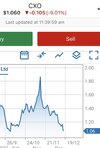Taylor
Community Leader
- Moderator
- #3,776
Question: I have been reading up that I also, as a pleb regular investor, cannot access high leverage CFDs but if I could - what is stopping me taking a position that a share price on a speculative stock will drop, leverage that position by hundreds of times and then selling shares I have in the speculative stock so the price falls before closing out my position on the CFD and pocketing my bulk returns?






